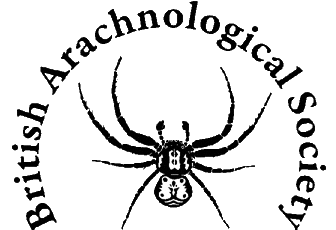To Weave an Orb Web
The orb web is a delight to the eye and a marvel of construction. The best way to see how an orb-weaver makes its web is to watch it. Webs are constructed in many different ways depending on the species. Early in the morning, a spider will begin building its web by producing the bridge-line. There are two ways it can do this. Either it climbs to a suitable position above the ground and with the abdomen pointing into the air, produces silk. This drifts on the breeze until it snags on another support and is then pulled tight. Alternatively, the spider fixes the silk at the top of a twig then, trailing silk, walks down, along and back up again. It then pulls the strand tight and fixes it firmly.
The gap between the two supports is now bridged and the spider crosses to the other side, laying down another, stronger strand. Some spiders, like the Garden Spider, Araneus diadematus, break the original bridge-line and gather it in as they cross and lay down the stronger drag-line. Going back and forth, further strands are added to make a strong line.
A branched thread is then made beneath the bridge-line. The spider crosses the bridge line, trailing a thread across. This remains free and not stuck to the bridge line, sagging in a loop. It fixes this line to the other support and climbs back along it causing it to sag. By measuring the tension on either side of the line, the spider is able to judge the central position of the strand. At this central point, the spider fixes its silk and drops down to a twig or the ground below. Here it pulls the vertical strand tight and fixes it, so forming a tight Y-shaped silken structure. The central hub of the web to be is at the point where the three spokes of the Y meet.
Next comes the framing phase. The spider climbs half way up one of the spokes, trailing silk as it goes which it then fixes. It then climbs halfway down this loop and fixes a further silk strand and climbs back up the opposite spoke and pulls the thread tight. A triangle is formed. This is repeated over and over again so that a series of triangles are made.
Many more spokes are added to the orb. By using its front legs, the spider is able to detect the distance between the spokes and fill in any large gaps. A new spoke is always added below an existing one. This results in an evenly spaced series of spokes. By checking the tension in the spokes, the spider is able to keep the web's hub even and central.
Now the spiral is formed. At the centre of the web there is a rough platform, formed by the spokes not finishing dead centre each time they were produced. The spider stands on this hub, facing in to the centre. Using its back legs to feel the spokes, the spider revolves and deposits a tight spiral of silk called the strengthening spiral.
The spider now lays down a widely spaced silken spiral, moving from the hub to the outside. This spiral is only temporary and is used in order to support itself as it lays down the sticky, elastic and stronger 'capture thread'. This thread is laid down from the outside of the web inwards to the hub. It forms a more closely spaced spiral than the temporary one. At first it is moist but as the spider stretches it the sticky liquid breaks into a series of droplets. The spider uses its legs to measure as it rapidly circles and spirals into the hub. It does this by sensing the angle between the bent jointed legs and keeping that angle constant.
The spider can now stand on her non-sticky hub and wait for prey to fly into the web. If you poke a spider on its web, it usually drops straight to the ground on a silken strand and then hides. Sometimes the spider has an escape route on her web that she runs up. Once the danger has passed the spider will return to the hub, and again wait, head down, for the next meal.
